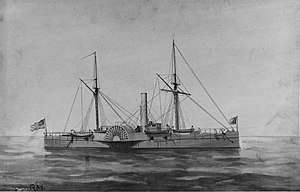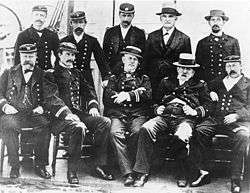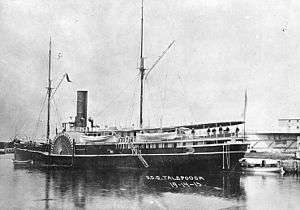USS Tallapoosa (1863)
USS Tallapoosa (1863) was a wooden-hulled, double-ended steamer in the United States Navy during the American Civil War. She was outfitted with heavy guns for intercepting blockade runners and howitzers for shore bombardment.
 Wash drawing by Clary Ray, circa 1900, depicting Tallapoosa as she appeared during the American Civil War. | |
| History | |
|---|---|
| Name: | USS Tallapoosa |
| Namesake: | A navigable river which rises in Paulding County in northwestern Georgia |
| Builder: | New York Navy Yard |
| Laid down: | date unknown |
| Launched: | 17 February 1863 |
| Commissioned: | 13 September 1864 |
| Decommissioned: | circa 30 January 1892 |
| Stricken: | 1892 (est.) |
| Fate: | sold at Montevideo, Uruguay, on 3 March 1892 |
| General characteristics | |
| Class and type: | Sassacus |
| Displacement: | 974 tons |
| Length: | 205 ft (62 m) |
| Beam: | 35 ft (11 m) |
| Draft: | 6 ft 6 in (1.98 m) |
| Depth of hold: | 11 ft 6 in (3.51 m) |
| Propulsion: |
|
| Speed: | 11.5 knots |
| Complement: | 190 officers and enlisted |
| Armament: |
|
| Notes: | double ended |
Tallapoosa remained in service after the war and served in various capacities, including schoolship for midshipmen of the United States Naval Academy. She was sold in Uruguay in 1892.
Built by the New York Navy Yard
Tallapoosa – the first U.S. Navy ship to have that name—was built at the New York Navy Yard by C. W. Booz of Baltimore, Maryland on similar plans as Sassacus. She was launched on 17 February 1863 and commissioned on 13 September 1864, Lieutenant Commander Joseph E. DeHaven in command.
Civil War service
Searching for CSS Tallahassee
As Tallapoosa was being fitted out, Confederate cruiser Tallahassee was cruising off the Atlantic coast destroying Union shipping from the Virginia Capes to Nova Scotia. Hence, the Union double-ender got underway late in October and spent her first days at sea in seeking the Southern commerce raider.
Her quest took her from New York City to Halifax, then south to the Virginia Capes, then back north again to the coast of Nova Scotia. On 4 November, Tallapoosa encountered a southeasterly gale, which battered the ship for the next two days, disabled both her rudders, and caused other damage. She finally made port at Boston, Massachusetts on the morning of the 7th.
Assigned to the East Gulf blockade
Following repairs at the Boston Navy Yard which lasted over a month and one-half, Tallapoosa was assigned to the East Gulf Blockading Squadron. Her most notable duty during this assignment occurred on 11 January 1865 when she assisted in salvaging material and equipment from screw frigate San Jacinto which had run aground in the Bahamas on an uncharted reef near Green Turtle Cay off Grand Abaco Island.
Post-war service
After the American Civil War ended, Tallapoosa served in the Gulf Squadron—cruising in the West Indies and the Gulf of Mexico—until 1867 when she was laid up at the Washington Navy Yard.
Admiral Farragut on board

Reactivated in 1869, the ship became a dispatch vessel, beginning a role which soon brought Tallapoosa one of her more interesting missions. In January 1870, she carried Admiral David Farragut to Portland, Maine, where he met HMS Monarch at the end of that British turreted battleship's voyage across the Atlantic Ocean to return to the United States the remains of philanthropist George Peabody who had died in England.
Early the following summer, the double-ender carried Farragut from New York City to Portsmouth, New Hampshire, to visit the commandant of the navy yard. It was hoped that the cool sea breezes of New England would improve the aged and ailing admiral's health. As Tallapoosa neared Portsmouth on 4 July, she fired an Independence Day salute to her famous passenger, the Navy's highest ranking and most respected officer. Upon hearing the warship's guns, Farragut left his sick-bed, donned his uniform, and walked to the man-of-war's quarterdeck. There he commented, "It would be well if I died now, in harness. ..." A month and 10 days later, Farragut died at Portsmouth.
Schoolship for the Naval Academy

In 1872, Tallapoosa moved to Annapolis, Maryland, to serve as a training ship at the United States Naval Academy. The following year, she became a transport. While she performed this duty, her years of service began to show, and it became apparent that she needed extensive repair work. Hence, the ship was largely rebuilt at Baltimore, Maryland, in 1874 and 1875. There, revitalized and configured as a single-ender, the veteran warship resumed her role as a dispatch vessel and continued performing as such for almost a decade.
Raised after sinking
Shortly before midnight on 24 August 1884, Tallapoosa collided with schooner J. S. Lowell and sank about five miles from Vineyard Haven, Massachusetts. After the ship had been raised and repaired by the Merritt Wrecking Company, she was recommissioned at the New York Navy Yard on 11 January 1886. Assigned to the South Atlantic Squadron, Tallapoosa departed New York on 7 June 1886, bound for Rio de Janeiro.
Sold in Uruguay
Tallapoosa served along the coast of South America until 30 January 1892 when she was condemned as unfit for further service. She was sold at public auction at Montevideo, Uruguay, on 3 March 1892.
References
- This article incorporates text from the public domain Dictionary of American Naval Fighting Ships. The entry can be found here.
External links
- USS Tallapoosa (1864-1892)
- U.S.S. Tallapoosa Financial Records, 1886-1888 MS 257 held by Special Collections & Archives, Nimitz Library at the United States Naval Academy